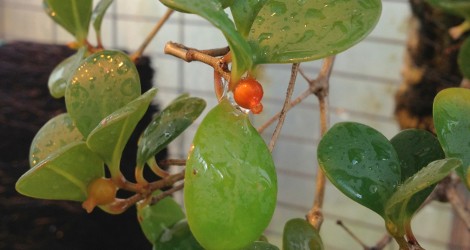Accession Data:
Pachycentria glauca Triana
- Common Name: Pachycentria
- Family: Melastomataceae Juss.
- Country of Origin: peninsular Malaysia
- Habitat: Epiphyte associated with ant nests.
- Description: Pachycentria glauca are small epiphytes commonly associated with ant nests and myrmecophytes such as Hynophytum and Dischidia. The plants provide pearl bodies, tiny lipid-rich, hence ant-nutritious foods on their leaves, stems, inflorescences and even flowers, which when eaten contribute to the energy budget of resident ant colonies. Pachycentria tubers have the anatomical structure of storage roots and are not ant inhabited unless as sometimes happens the epidermis of some tubers crack and they become hollow. 2 They are dispersed over longer distances by small to middle-sized birds that eat the fleshy berries. However, ants possibly reclaim some seed from bird droppings and probably glean both food and seed directly from the berries themselves.2
- USDA Zone: 10-11?
Accession Data:
- Accession # 201100231
- Source: Black Jungle
- Accession Date: 09-20-2011
- Bench: 4104 - EPI: East Rack B
- Currently: active - healthy
- Qty: 2 confirmed on 11-22-2024
Classification:
- Division: Magnoliophyta
- Class: Magnoliopsida
- SubClass: rosids
- Order: Myrtales
- SubOrder:
- Family: Melastomataceae
- SubFamily: Melastomatoideae
- Tribe: Miconieae
- SubTribe:
Flowering Data:
This accession has been observed in bloom on:| Year | Jan | Feb | Mar | Apr | May | Jun | Jul | Aug | Sep | Oct | Nov | Dec | ||||||||||||||||||||||||||||||||||||||||
|---|---|---|---|---|---|---|---|---|---|---|---|---|---|---|---|---|---|---|---|---|---|---|---|---|---|---|---|---|---|---|---|---|---|---|---|---|---|---|---|---|---|---|---|---|---|---|---|---|---|---|---|---|
| 2025 | ||||||||||||||||||||||||||||||||||||||||||||||||||||
| 2024 | ||||||||||||||||||||||||||||||||||||||||||||||||||||
| 2023 | ||||||||||||||||||||||||||||||||||||||||||||||||||||
| 2022 | ||||||||||||||||||||||||||||||||||||||||||||||||||||
| 2021 | ||||||||||||||||||||||||||||||||||||||||||||||||||||
| 2020 | ||||||||||||||||||||||||||||||||||||||||||||||||||||
| 2019 | ||||||||||||||||||||||||||||||||||||||||||||||||||||
| 2018 | ||||||||||||||||||||||||||||||||||||||||||||||||||||
| 2017 | ||||||||||||||||||||||||||||||||||||||||||||||||||||
| 2016 | ||||||||||||||||||||||||||||||||||||||||||||||||||||
| 2015 | ||||||||||||||||||||||||||||||||||||||||||||||||||||
| 2014 | ||||||||||||||||||||||||||||||||||||||||||||||||||||
| 2013 | ||||||||||||||||||||||||||||||||||||||||||||||||||||
| 2012 | ||||||||||||||||||||||||||||||||||||||||||||||||||||
References (internal):
- Ant Plants (myrmecophytes)
- EEB 3271 - Systematic Botany
- AntU - Learning from the Complex Society of Army Ants & Their Guests
References (external):
- The Plant List (2013). Version 1.1. Last accessed on Wednesday, 26 December, 2018.
- Maelastomataceae Epiphytes at Forum for Epiphytic Myrmecophytes. Last accessed Wednesday, 26 December, 2018.
data regenerated on Sat, 11 Jan 2025 12:03:06 -0500 [bcm v4.0]
Images:

Additional images for this accession:
Click on thumbnails to enlargeCurrent Accessions in the Melastomataceae
Subfamily Melastomatoideae
Tribe Melastomeae
Subfamily Melastomatoideae
Tribe Miconieae
Subfamily Melastomatoideae
Tribe Sonerileae
W/C = Wild Collected
 = indicates flowering in past 14 days
= indicates flowering in past 14 days
 = images available for this accession
= images available for this accession
 = map available for this accession
= map available for this accession
 = accession added within past 90 days
= accession added within past 90 days

